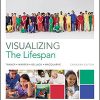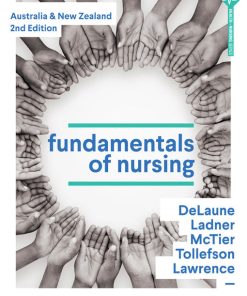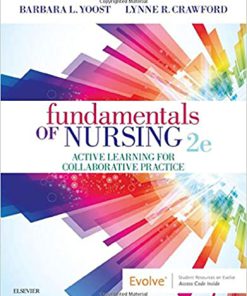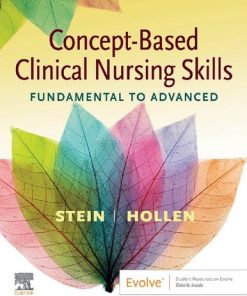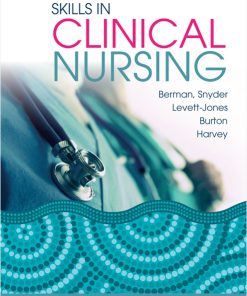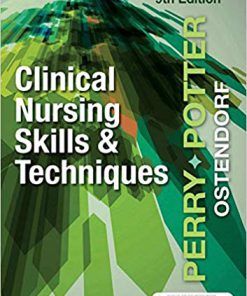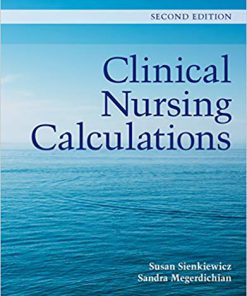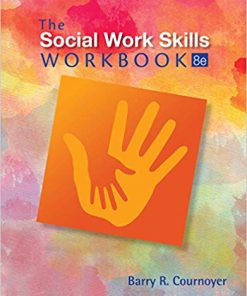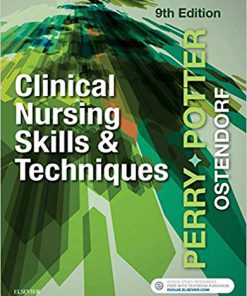(Original PDF) Fundamentals of Nursing Clinical Skills Workbook 2nd
$50.00 Original price was: $50.00.$35.00Current price is: $35.00.
(Original PDF) Fundamentals of Nursing Clinical Skills Workbook 2nd – Instant Download
(Original PDF) Fundamentals of Nursing Clinical Skills Workbook 2nd – Digital Ebook – Instant Delivery Download

product details:
- ISBN-10 : 9780729541169
- ISBN-13 : 978-0729541169
- Author: Geraldine Rebeiro RN RM BAppSc(AdvNurs) BEdStuds MEd, Damian Wilson RN BNurs GradCertEmergNurs GradCertEd(HEd) MNursing(EmergCare)
Fundamentals of Nursing: clinical skills workbook, 2nd edition will assist Australian and New Zealand students to master the clinical nursing skills they require to deliver the highest quality of care to their patients.
Nursing students and lecturers familiar with the Nursing Skills format in Potter and Perry’s Fundamentals of Nursing will benefit from this separate, lightweight workbook which enables students to easily transport the skills content to lectures, labs and clinical practice. Additionally, the clinical skills workbook provides students with a clear and accessible personal record of achievement and allows an opportunity for reflection to encourage meaningful learning.
The simple structure of the workbook allows students to work through and master the skills necessary to become a competent, qualified nurse.
A concise Overview precedes each skill set followed by the trusted Step-by-step approach and Rationales to help students understand how and why a skill is performed. . Each skill is then assessed using the competency check lists which are aligned to the National Competency Standards for the Registered Nurse for Australia and New Zealand and support the theory and practice of each skill.
table of contents:
Chapter 14 Placing communication at the heart of person-centred care
14-1 Patient handover
Chapter 16 Monitoring vital signs: using a primary survey approach for patient assessment
16-1 Assessing respirations
16-2 Measuring oxygen saturation (SpO2)
16-3 Assessing the radial and apical pulses
16-4 Measuring blood pressure (BP)
16-5 Measuring body temperature
Chapter 17 Undertaking a focused assessment: Physical assessment of body systems
17-1 Nursing physical assessment using a body systems framework
17-2 Focused neurological assessment
17-3 Focused cardiovascular assessment
17-4 Focused respiratory assessment
17-5 Focused gastrointestinal assessment
17-6 Focused renal assessment
17-7 Focused musculoskeletal assessment
17-8 Focused skin or integumentary assessment
Chapter 18 Understanding infection control
18-1 Hand washing
18-2 Preparing an aseptic field
18-3 Surgical hand antisepsis (‘scrubbing’): preparing for gowning and gloving
18-4 Open gloving
18-5 Donning a sterile gown and performing closed gloving
Chapter 19 Optimising skin integrity and wound care
19-1 Performing a bacterial wound swab
19-4 Performing a wound dressing
19-2 Assessment, management and prevention of skin tears
19-3 Assessment for risk of pressure injury
Chapter 20 Ensuring medication safety
20-1 Administering oral medications
20-2 Administering nasal instillations
20-3 Administering ophthalmic medications
20-4 Administering vaginal medications
20-5 Administering rectal suppositories
20-6 Using metred-dose inhalers (MDIs)
20-7 Preparing injections
20-8 Administering injections
20-9 Adding medications to intravenous fluid containers
20-10 Administering medications by intravenous bolus
20-11 Administering intravenous medications by a secondary infusion
20-12 Administering intravenous medications by a syringe driver/mini-Infuser pump (New)
Chapter 21 Preventing and managing immobility
21-1 Applying sequential compression devices (SCDs)
21-2 Compression stockings
21-3 Positioning patients in bed
21-4 Transfer techniques
Chapter 22 Assessing and managing pain
22-1 Focused pain assessment
Chapter 23 Supporting oxygenation and perfusion
23-1 Using a hand-held doppler ultrasound probe to assess peripheral pulses (New)
23-2 Continuous Cardiac Monitoring (CCM)
23-3 Conducting a 12 Lead ECG
23-4 Suctioning
23-5 Care of patients with chest tubes
23-6 Applying a nasal cannula or oxygen mask
23-7 Cardiopulmonary resuscitation – basic life support
Chapter 24 Balancing fluid, electrolyte and acid-base status
24-1 Assessment of fluid status
24-2 Subcutaneous infusion (hypodermoclysis)
24-3 Initiating a peripheral intravenous (IV) infusion
24-4 Regulating intravenous flow rate
24-5 Changing intravenous solution and infusion tubing
24-6 Changing a peripheral intravenous dressing
24-7 Care of the patient requiring a blood transfusion
Advanced Skills Management of Central Venous Catheters (CVC)
Adv. Skill 1 Regulating CVC intravenous flow rate
Adv. Skill 2 CVC dressing change and flush
Chapter 25 Meeting nutritional needs
25-1 Inserting a small-bore nasoenteric tube for enteral feedings
25-2 Administering enteral feedings via nasoenteric tubes
25-3 Administering enteral feedings via gastrostomy or jejunostomy tube
25-4 Blood glucose levels (NEW)
Chapter 26 Ongoing hygiene
26-1 Bathing a person
26-2 Perineal care
26-3 Menstrual hygiene
26-4 Administering a back rub
26-5 Performing nail and foot care
26-6 Providing oral hygiene
26-7 Performing mouth care for an unconscious or debilitated client
26-8 Caring for the person with contact lenses
26-9 Making an occupied bed
26-10 Making a post-operative bed
Chapter 27 Maintaining elimination: urinary
27-1 Bladder Ultrasound (New)
27-2 Collecting a mid-stream (clean-voided) urine specimen
27-3 Applying a sheath/condom drainage device
27-4 Inserting a straight or indwelling catheter
Additional Skill 1 NEW Pouching a urostomy
Chapter 28 Maintaining elimination: bowel
28-1 Administering a prepared enema
28-2 Pouching an ostomy
28-3 Inserting and maintaining a nasogastric tube (for decompression)
Chapter 39 Working in acute care environments
39-1 Assessment and management of the deteriorating patient ABCDE
Chapter 40 Working in the mental health sector
40-1 Mental state examination
people also search:
You may also like…
Medicine - Nursing
Fundamentals of Nursing 2nd Edition Lauren Mctier – eBook PDF
Ebook-PDF
(eBook PDF) Fundamentals of Nursing: Active Learning for Collaborative Practice 2nd Edition
Medicine
Concept-Based Clinical Nursing Skills: Fundamental to Advanced 1st Edition Stein – eBook PDF


